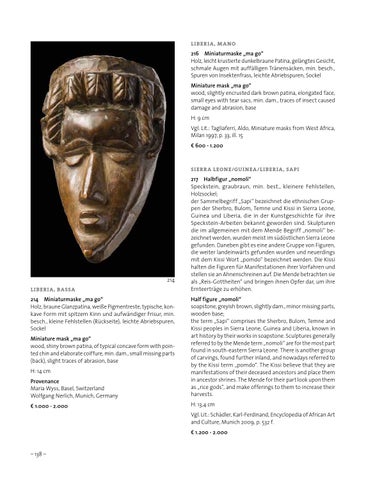Liberia, M ano
216 Miniaturmaske „ma go“ Holz, leicht krustierte dunkelbraune Patina, gelängtes Gesicht, schmale Augen mit auffälligen Tränensäcken, min. besch., Spuren von Insektenfrass, leichte Abriebspuren, Sockel Miniature mask „ma go“ wood, slightly encrusted dark brown patina, elongated face, small eyes with tear sacs, min. dam., traces of insect caused damage and abrasion, base H: 9 cm Vgl. Lit.: Tagliaferri, Aldo, Miniature masks from West Africa, Milan 1997, p. 33, ill. 15 € 600 - 1.200
Sierr a Leone/Guinea/Liberia, Sa pi
214 Liberia, Bassa
214 Miniaturmaske „ma go“ Holz, braune Glanzpatina, weiße Pigmentreste, typische, konkave Form mit spitzem Kinn und aufwändiger Frisur, min. besch., kleine Fehlstellen (Rückseite), leichte Abriebspuren, Sockel Miniature mask „ma go“ wood, shiny brown patina, of typical concave form with pointed chin and elaborate coiffure, min. dam., small missing parts (back), slight traces of abrasion, base H: 14 cm Provenance Maria Wyss, Basel, Switzerland Wolfgang Nerlich, Munich, Germany € 1.000 - 2.000
217 Halbfigur „nomoli“ Speckstein, graubraun, min. best., kleinere Fehlstellen, Holzsockel; der Sammelbegriff „Sapi“ bezeichnet die ethnischen Gruppen der Sherbro, Bulom, Temne und Kissi in Sierra Leone, Guinea und Liberia, die in der Kunstgeschichte für ihre Speckstein-Arbeiten bekannt geworden sind. Skulpturen die im allgemeinen mit dem Mende Begriff „nomoli“ bezeichnet werden, wurden meist im südöstlichen Sierra Leone gefunden. Daneben gibt es eine andere Gruppe von Figuren, die weiter landeinwärts gefunden wurden und neuerdings mit dem Kissi Wort „pomdo“ bezeichnet werden. Die Kissi halten die Figuren für Manifestationen ihrer Vorfahren und stellen sie an Ahnenschreinen auf. Die Mende betrachten sie als „Reis-Gottheiten“ und bringen ihnen Opfer dar, um ihre Ernteerträge zu erhöhen. Half figure „nomoli“ soapstone, greyish brown, slightly dam., minor missing parts, wooden base; the term „Sapi“ comprises the Sherbro, Bulom, Temne and Kissi peoples in Sierra Leone, Guinea and Liberia, known in art history by their works in soapstone. Sculptures generally referred to by the Mende term „nomoli“ are for the most part found in south-eastern Sierra Leone. There is another group of carvings, found further inland, and nowadays referred to by the Kissi term „pomdo“. The Kissi believe that they are manifestations of their deceased ancestors and place them in ancestor shrines. The Mende for their part look upon them as „rice gods“, and make offerings to them to increase their harvests. H: 13,4 cm Vgl. Lit.: Schädler, Karl-Ferdinand, Encyclopedia of African Art and Culture, Munich 2009, p. 532 f. € 1.200 - 2.000
– 138 –
